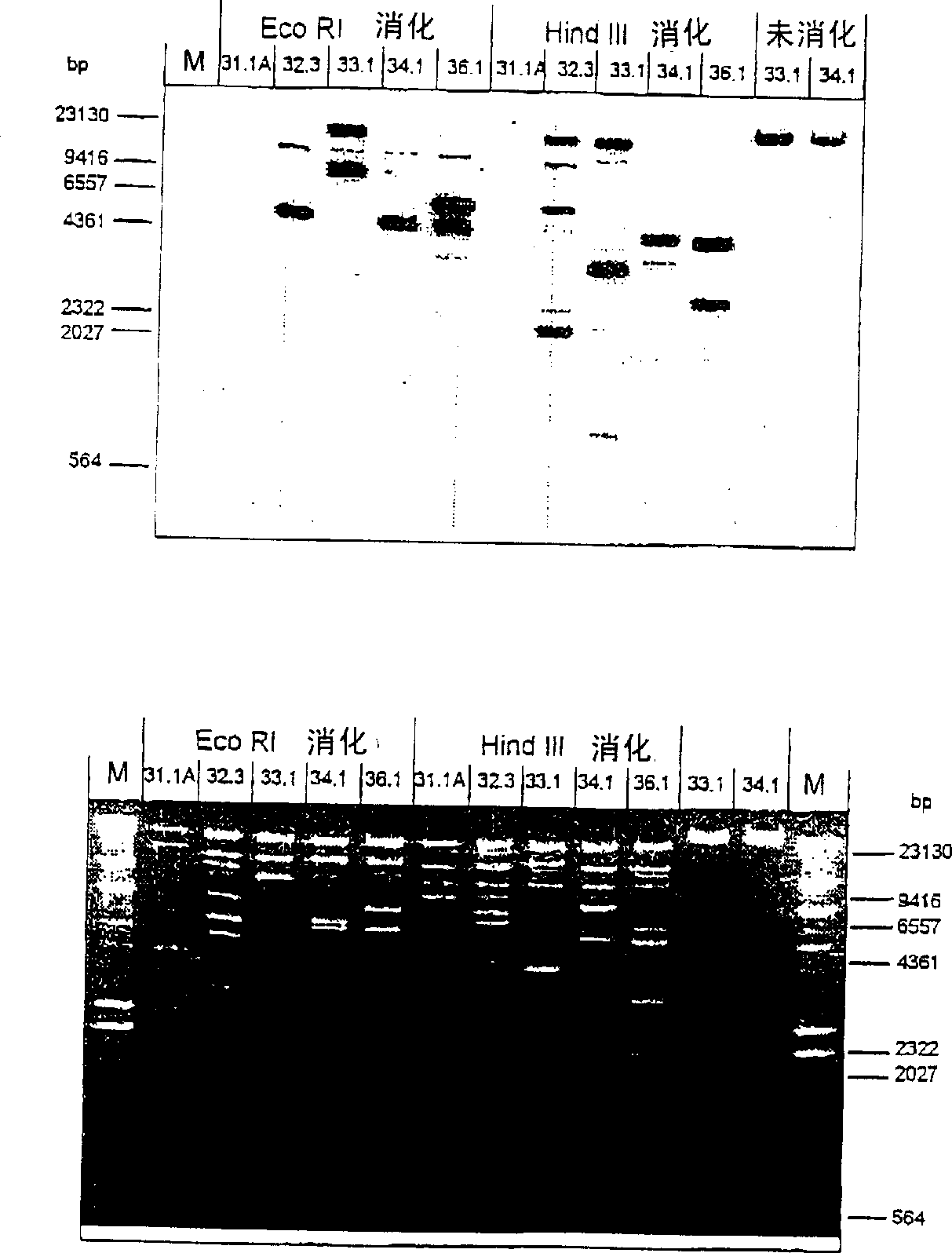Determination of genetic sex in equine species by analysis of Y-chromosomal DNA sequence
A Y chromosome and sequence technology, applied in the field of determining the genetic sex of horse species by analyzing the Y chromosome DNA sequence, can solve the problem that the genetic sex of microbiopsy samples is useless
- Summary
- Abstract
- Description
- Claims
- Application Information
AI Technical Summary
Problems solved by technology
Method used
Image
Examples
Embodiment 1
[0140] Genomic DNA preparation from horse blood samples:
[0141] Collect horse blood samples in 10ml EDTA Vacutainers , immediately placed on ice and sent to the laboratory within 2 days. It was found that samples could be stored in the Vacutainer(R) for up to 6 months without significant loss of yield and quality of DNA obtained therefrom.
[0142] 25ml of cold lysis buffer (lysis buffer) (0.32M sucrose, 10mM tris-HCl, pH7.5, 5mM MgCl 2 , 10% (v / v) Triton X-100) was added to 10ml of whole blood. The suspension was centrifuged at 4000 xg for 20 minutes at 4°C, the pelleted cells were resuspended in PBS and centrifuged again. Then, the cells were suspended in 9 ml TE. The suspension was adjusted to 25 mM EDTA, 0.5% (w / v) SDS and 0.1 mg / ml proteinase K (Boehringer Mannheim), and the lysed mixture was incubated overnight at 37°C with gentle agitation. Digested samples were extracted with 5 ml phenol / chloroform (equal volumes of phenol equilibrated with tris-HCl / EDTA (Sigm...
Embodiment 3
[0206] Using the conditions described above, clone sequence EY.AI5 was indexed with DIG and hybridized with Southern blots of male and female genomic DNA that had been isolated from horses of different breeds and digested with Sau3AI (Fig. 1). Hybridization patterns were similar to all breeds examined, including the subspecies known as the Mongolian Mustang. This suggests that the EY.AI5 sequence is sex-differentiated across the Equus cabullus species. Example 3 Conceptual Basis for Discriminative PCR-Based Sex Determination
[0207] Each of the four male-associated DNA sequences is clearly present on the horse's Y chromosome, as each exhibits male-specific interbreeding patterns. But none were unique to the male genome. Of the four candidates to target for a diagnostic test of the equine chromosome, the EY.AI5 fragment clearly offered the greatest likelihood, as it showed the greatest difference between abundance on the Y chromosome and elsewhere. Therefore, further studie...
Embodiment 4
[0212] Two regions of the fragment derived directly from the male genome differ from the equivalent regions (nucleotides 1-30 and nucleotides 162-220) derived from the female fragment. These regions of differing sequence were selected as annealing targets for PCR primers designed to identify the EY.AI5 sequence of male and female genomic DNA. Example 4 Development of PCR-Based Equine Sex Identification Analysis
[0213] One primer pair was derived from the sequence data in Figure 2 for the specific detection of horse Y-chromosomal DNA. These primers are: EQYL2: 5'-AGCGGAGAAAGGAATCTCTGG-3' (SEQ ID NO: 12) and EQYR5: 5'-TACCTAGCGCTTCGTCCTCTAT-3' (SEQ ID NO: 13), which were respectively derived from (underlined) in Figure 2 The reverse complement of nucleotides 6-26 and nucleotides 184-205 of the male genomic DNA sequence of , exhibits distinct sequence differences between these two regions of the male and female genomes.
[0214] Amplification of equine genomic DNA samples wit...
PUM
 Login to View More
Login to View More Abstract
Description
Claims
Application Information
 Login to View More
Login to View More - Generate Ideas
- Intellectual Property
- Life Sciences
- Materials
- Tech Scout
- Unparalleled Data Quality
- Higher Quality Content
- 60% Fewer Hallucinations
Browse by: Latest US Patents, China's latest patents, Technical Efficacy Thesaurus, Application Domain, Technology Topic, Popular Technical Reports.
© 2025 PatSnap. All rights reserved.Legal|Privacy policy|Modern Slavery Act Transparency Statement|Sitemap|About US| Contact US: help@patsnap.com



